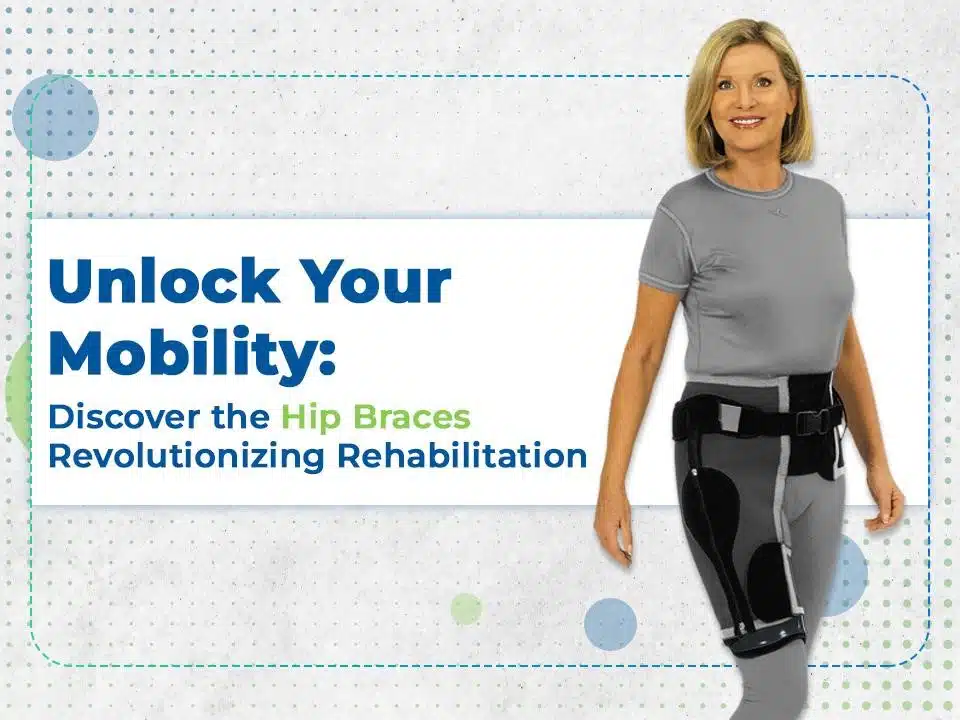Hip injuries or conditions can significantly impact mobility, causing discomfort and limitations in daily activities. Fortunately, the development of advanced hip braces has revolutionized the field of rehabilitation, offering individuals support, stability, and pain relief. In this article, we will explore how hip braces are transforming rehabilitation, their benefits, different types, and how they can unlock your mobility for a seamless recovery.
Understanding Hip Braces and Their Benefits
The hip joint is perhaps the joint that can best take on repetitive motion and a fair amount of wear and tear. It’s the second-largest joint in the body, which means that when pain is present, it can impair your quality of life.
With age and use, the cartilage on the hip joint can wear down, and the muscles and tendons can get overexerted. Older adults often experience hip pain due to osteoarthritis, rheumatoid arthritis, or injuries from long ago that didn’t heal properly. Whatever the cause of the pain may be, a medical hip brace can help restore your mobility.
Hip braces are orthopaedic devices designed to provide support, stability, and pain relief to the hip joint. These braces assist in the rehabilitation process by promoting proper alignment, reducing stress on the hip, and facilitating healing. The benefits of using hip braces include pain alleviation, enhanced mobility, improved posture, and accelerated recovery.
Common Hip Conditions and the Need for Hip Braces
Hip braces are particularly beneficial for individuals with various hip conditions or injuries. Understanding these conditions helps identify the need for hip braces as part of an effective rehabilitation strategy.
- Hip Osteoarthritis: Osteoarthritis is a degenerative joint disease that affects the cartilage in the hip joint, leading to pain, stiffness, and reduced mobility. Hip braces can provide stability, support, and pain relief, allowing individuals with hip osteoarthritis to engage in daily activities with less discomfort.
- Hip Fractures: Hip fractures are common injuries, especially among older adults. Hip braces play a crucial role in the rehabilitation process after surgical repair or fracture healing. They provide support, promote proper alignment, and aid in walking or weight-bearing activities during recovery.
- Hip Labral Tears: Labral tears are injuries to the cartilage lining the hip socket. Hip braces can help reduce pain and provide stability to the hip joint, allowing individuals with labral tears to regain mobility and participate in rehabilitation exercises.
- Hip Bursitis: Hip bursitis is inflammation of the bursae, fluid-filled sacs that cushion the hip joint. Hip braces can alleviate pressure on the inflamed bursae, reduce pain, and provide compression to promote healing and reduce inflammation.
Types of Hip Braces
Different types of hip braces are available to cater to specific conditions, injuries, and rehabilitation goals. Understanding these types can assist in choosing the most appropriate hip brace for individual needs.
- Compression Hip Braces: Compression hip braces provide support and compression to the hip joint. They improve stability, reduce swelling, and promote circulation, aiding in pain relief and recovery from various hip conditions.
- Trochanteric Support Braces: Trochanteric support braces target the greater trochanter region of the hip, providing compression and support to the lateral hip muscles and tendons. These braces are commonly used for conditions such as trochanteric bursitis or IT band syndrome.
- Hip Abduction Braces: Hip abduction braces are used to immobilize or limit movement in the hip joint. They are often prescribed after hip surgeries, such as hip replacement or repair of hip fractures, to aid in proper healing and prevent dislocation.
- Hip Stabilization Braces: Hip stabilization braces provide stability and support to the hip joint. They are commonly used in cases of hip instability, hip dysplasia or during post-surgical rehabilitation to facilitate proper alignment and protect the joint.
Benefits of Hip Braces in Rehabilitation
Hip braces offer several benefits in the rehabilitation process, helping individuals regain mobility and improve overall function. Some key benefits include:
- Pain Relief: Hip braces help reduce pain by providing support, stability, and compression to the affected area. This can alleviate discomfort, allowing individuals to engage in rehabilitation exercises and activities with greater ease.
- Improved Mobility: By providing support and stability, hip braces enhance mobility, allowing individuals to move more comfortably and perform daily activities without excessive strain or pain.
- Posture Correction: Certain hip braces are designed to promote proper posture, which can help alleviate pressure on the hip joint and improve overall alignment. Correcting posture aids in reducing pain and facilitating optimal healing during the rehabilitation process.
- Accelerated Recovery: Hip braces aid in the rehabilitation and recovery process by protecting the hip joint, providing stability during weight-bearing activities, and facilitating proper movement patterns. These factors contribute to faster healing and a smoother recovery journey.
Remember, hip braces are valuable tools that can aid in pain relief, enhance stability, and accelerate the rehabilitation process. You can unlock your mobility and regain independence by consulting with healthcare professionals, choosing the right hip brace, and incorporating it into a comprehensive rehabilitation program. Embrace the transformative power of hip braces and take the first step towards a seamless recovery and an active, pain-free lifestyle.
Read More: Hip Braces for Enhanced Mobility and Comfort: Artik Medical Supply Has You Covered
Choosing the Right Hip Brace
Selecting the appropriate hip brace is essential to ensure optimal support, comfort, and effectiveness. Consider the following factors when choosing a hip brace:
- Consultation with a Healthcare Professional: Seek guidance from a healthcare professional or orthopedic specialist who can evaluate your specific condition, recommend suitable options, and ensure proper fit.
- Fit and Comfort: Choose a hip brace that offers a secure and comfortable fit. Adjustable straps, padding, and breathable materials contribute to overall comfort, allowing for extended use without discomfort.
- Level of Support: Assess the level of support required based on your specific condition, activity level and the recommendations of your healthcare professional. Different hip braces provide varying degrees of support, so select the one that matches your needs.
- Ease of Use: Opt for a hip brace that is easy to put on and take off, ensuring convenience and hassle-free use during rehabilitation exercises and daily activities.
- Quality and Durability: Invest in a high-quality hip brace made from durable materials to withstand regular use during the rehabilitation process. Sturdy construction ensures long-term support and effectiveness.
Incorporating Hip Braces into Rehabilitation
Proper use of hip braces in conjunction with rehabilitation exercises is crucial for optimal recovery. Here are some guidelines for incorporating hip braces into the rehabilitation process:
- Follow Healthcare Professional’s Recommendations: Adhere to the guidelines provided by your healthcare professional regarding the duration and frequency of hip brace usage. They will determine the appropriate duration and activities that can be performed while wearing the brace.
- Combine with Rehabilitation Exercises: Hip braces often work synergistically with rehabilitation exercises prescribed by physical therapists. The brace provides additional support, stability, and protection to the hip joint during exercises, facilitating proper movement patterns and promoting healing.
- Gradual Progression: Gradually increase the intensity and duration of exercises while wearing the hip brace as recommended by your healthcare professional. This approach allows your body to adapt and build strength progressively, minimizing the risk of re-injury.
- Consistency and Compliance: Wear the hip brace consistently as directed by your healthcare professional. Consistent usage ensures continuous support, stability, and pain relief throughout the rehabilitation process.
Unlocking Mobility Beyond Rehabilitation
While hip braces play a crucial role in rehabilitation, it’s important to focus on long-term hip health. Once rehabilitation is complete, continue to prioritize hip health through regular exercise, maintaining a healthy weight, practising proper posture, and avoiding excessive strain on the hip joint.
Always consult with a healthcare professional or orthopaedic specialist to determine the most suitable hip brace for your specific condition and requirements. Prioritize your hip health and invest in the support and stability provided by hip braces to unlock your mobility and embrace a life free from pain and limitations.
Conclusion
Hip braces have revolutionized the field of rehabilitation, offering individuals support, stability, and pain relief during the recovery process. By understanding the benefits and different types of hip braces available, individuals can select the most suitable brace to unlock their mobility and achieve a seamless recovery. Consult with a healthcare professional to determine the most appropriate hip brace for your specific condition and requirements. Embrace the support of hip braces as you embark on your journey towards improved mobility and pain-free life.
If you’ve been dealing with hip pain or are recovering from injury or surgery, be sure to get the hip support your need. Artik Medical Supply is here for you. Their medical hip brace product is lightweight, breathable, and supportive. It’s easy to adjust for abduction and offers a customizable fit. Contact them today for a free insurance eligibility check.









